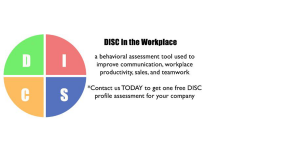Many businesses already see the value in assessing their employees’ personalities and behaviors with a DISC profile. But many forgo these assessments and the many benefits they add to their business because they simply don’t understand what a DISC profile is. Let’s take a closer look at what exactly goes into a DISC profile and how the assessment describes an individual’s behavior.

The assessment tool is based on a model created by William Molton Marston, a respected lawyer and psychologist, and it looks at four key factors to help describe an individual’s behavior traits. Marston is also credited with creating the world’s first polygraph lie detector test. The model is used to identify traits such as the following:
| • Achiever | • Developer | • Persuader |
| • Agent | • Inspirational | • Practitioner |
| • Appraiser | • Investigator | • Promoter |
| • Counselor | • Objective thinker | • Result-oriented |
| • Creative | • Perfectionist | • Specialist |
Emotions of Normal People
Plato wrote that the first and best victory is to conquer self. But the problem is that your employees can’t hope to conquer themselves without first knowing themselves. By using the DISC assessment tool, leaders will be able to more effectively manage their employees and set goals and challenges that better reflect individual personalities and aptitude. For example, imagine the ineptitude of casting an employee who leans more toward the creative side in a sales position (instead of a persuader/promoter).
The aforementioned traits are largely derived from his book titled Emotions of Normal People, in which he claimed that people express their emotions and feelings through four main behaviors including dominance, influence, steadiness, and conscientiousness. The following are some common behaviors within these four categories.
- Dominance – focuses on results and the bottom line, confident
- Can see the big picture
- Usually direct and communicates with candor
- Relishes challenges
- Doesn’t beat around the bushes
- Influence – persuades others and prefers open communication and strong relationships
- Has an enthusiastic behavior
- Typically very optimistic
- Works well in teams and collaborates effectively
- Doesn’t want to be ignored
- Steadiness – sincere, dependable, and cooperates well with others
- Dislikes fast deadlines and being rushed
- Calm mannerisms
- Relaxed approach to problem solving
- Supports others and shows humility
- Compliance – competent and prefers to be accurate
- Prefers to be independent
- Detail oriented
- Objective reasoning
- Is afraid of being wrong
Furthermore, a person’s emotional behavior is heavily influenced by two main factors. First of all, people are influenced by their environment and whether or not they view that environment as favorable. Second of all, a person is influenced by their perceived degree of control within that environment.
The assessment tool helps uncover and identify combinations of these traits to describe a complex behavior. By understanding behavior types, strengths, and weaknesses, an organization will be able to increase teamwork, productivity, and internal processes.
Seeking Assistance
It’s one thing to identify and admire brilliantly designed business cultures, but an entirely different matter to create one. For help developing your business culture, contact John M. Ruh and Associates.

Written by John Ruh
John M. Ruh and Associates are mission based business advisors who partner with growth oriented leaders to create the right P.S.T. support: the right People, the right Structure and the right Tools.